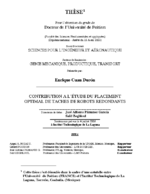Cuan Durón Enrique
Contribution à l'étude du placement optimal de taches de robots redondants
esConsulter le texte intégral de la thèse (format PDF)

Résumé
Français
Contribution à l'étude du placement optimal de taches de robots redondants
Les études menées dans cette thèse concernent le problème du placement optimal de tâches des robots redondants en vue d'améliorer leurs performances cinéstotatiques lors de l'exécution des tâches. Nous rappelons les concepts de la cinématique des manipulateurs ainsi que les notions de redondance et d'accessibilité. Nous examinons aussi les indices de performance cinématique proposés. Ensuite, nous évoquons les contributions existantes, sur le sujet du placement optimal robot / tâche. Ces travaux sont recensés selon trois groupes : ceux concernant l'accessibilité aux tâches; ceux consacrés à l'optimisation des performances cinétostatiques; et ceux envisageant la minimisation du temps du cycle. En tenant compte des limitations des méthodes publiées, nous résolvons le placement de tâches sous trois scénarios : optimisation d'un seul critère de performance pour un point de la tâche dans un environnement sans obstacles ; optimisation multicritère pour plusieurs points de la tâche dans un environnement sans obstacles ; et finalement optimisation globale d'un critère dans un environnement encombré. Nos méthodes constituent des contributions dans le domaine de la planification des mouvements des robots redondants. La prise en compte des contraintes assure l'obtention de solutions réalistes. Nous retenons deux aspects spécifiques de nos méthodes : le premier relatif à la démarche utilisée pour la synthèse de trajectoires articulaires continues entre les points-tâche dans le cas de l'optimisation multicritère ; le second relatif à la fonction objective que nous proposons dans le cas de la méthode avec contrainte anti-collisions. L'efficacité de nos méthodes est validée en les appliquant à des cas divers dans tous les scénarios envisagés.
Mots-clés libres : robotique, optimisation mathématique, robot, redondance, robots mouvements, robots programmation.
- Robotique
- Optimisation mathématique
- Redondance (ingénierie)
- Robots -- Mouvements
- Robots -- Programmation
English
Contribution to the study of the optimal placement of tasks of redundant robots
This thesis deals with the placement problem of tasks of redundant robotic manipulators in order to optimize the kinetostatic performances of the robots.The first part of the work addresses a review of the basic concepts of kinematics of manipulators and indices of kinetostatic performances.Then, an analysis is carried out of the proposed methods to solve the optimal placement problem. Three kinds of methods have been identified; they consider the following problems: tasks accessibility ; the optimization of kinetostatic performances; the minimization of cycle-time of tasks.The limitations observed in these works are taken into account in order to propose more efficient methods to compute the optimal placement robot / task.Three scenarios are considered in our work: the optimization of one index of performance for one task-point without obstacles in the environment; a multi-criteria optimization of performances for a number of task-points without obstacles in the environment; and finally, a global optimization of one index of performance taking into account the obstacle avoidance. Thanks to their features, our methods represent an interesting contribution in the area of motion planning of robotic manipulators.Namely, they take into account constraints in order to obtain realistic solutions including obstacle avoidance; on the other hand, the multi-criteria method uses an original algorithm in order to synthesize continuous joint trajectories respecting a prescribed law of motion.According to the knowledge of the author, there are no methods for task placement based on multi-criteria optimization neither by taking into account obstacle avoidance. The efficacy of the proposed methods is illustrated by considering several cases of study.
Español
Contribución al estudio del emplazamiento óptimo de tareas de robots redundantes
Notice
- Diplôme :
- Doctorat d'Université
- Établissement de soutenance :
- Université de Poitiers
- Établissement de co-tutelle :
- Instituto tecnologico de La Laguna (Torreon, Mexique)
- UFR, institut ou école :
- UFR des sciences fondamentales et appliquées (SFA)
- Laboratoire :
- L.M.S. - Lab. de mécanique des solides
- Domaine de recherche :
- Génie mécanique, productique, transport
- Directeur(s) de thèse :
- José Alfonso Pamanes Garcia, Saïd Zeghloul
- Date de soutenance :
- 03 juillet 2008
- Président du jury :
- Gérard Poisson
- Rapporteurs :
- Angel-Alfonso Rojas-Salgado
- Membres du jury :
- José Alfonso Pamanes Garcia, Saïd Zeghloul
Menu :
-
-
À propos d'UPthèses
-
Voir aussi
Annexe :
-
Une question ?
Avec le service Ubib.fr, posez votre question par chat à un bibliothécaire dans la fenêtre ci-dessous :
ou par messagerie électronique 7j/7 - 24h/24h, une réponse vous sera adressée sous 48h.
Accédez au formulaire...
Université de Poitiers - 15, rue de l'Hôtel Dieu - 86034 POITIERS Cedex - France - Tél : (33) (0)5 49 45 30 00 - Fax : (33) (0)5 49 45 30 50
these@support.univ-poitiers.fr -
Crédits et mentions légales
